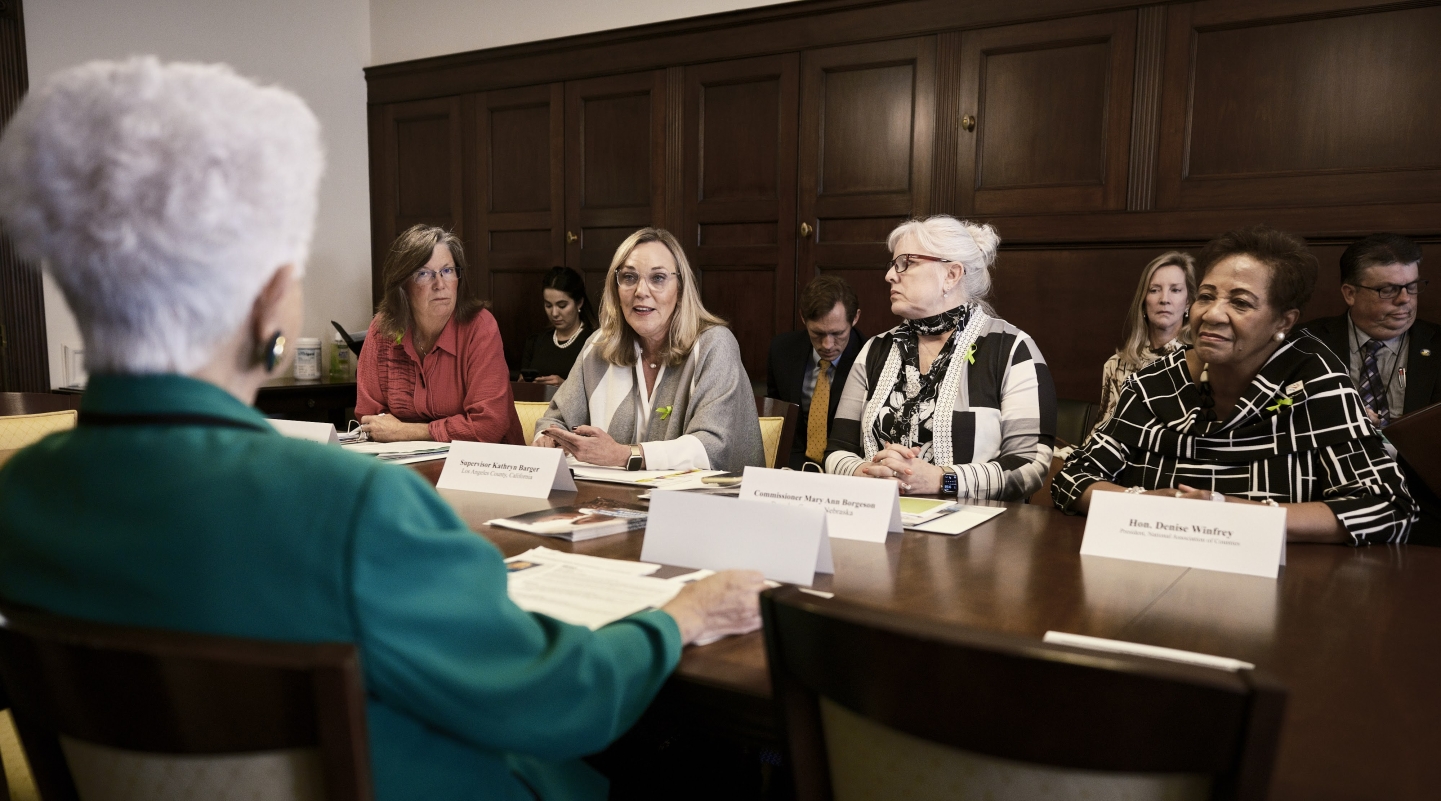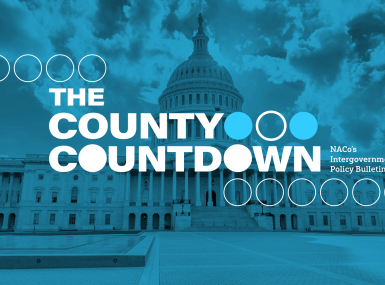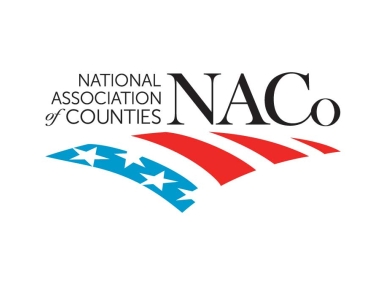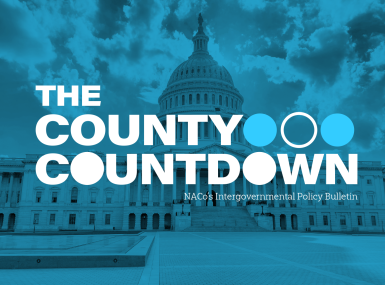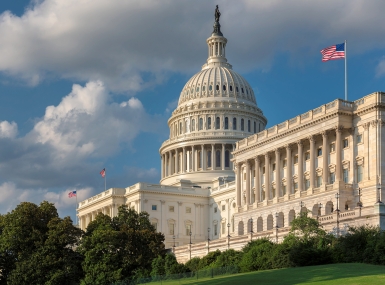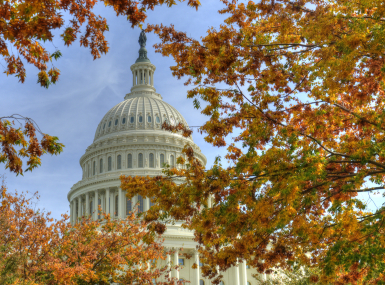What Counties Need to Know When a Government Shutdown Happens

Upcoming Events
Related News
A federal government shutdown, technically a "lapse in appropriations," occurs when Congress fails to pass the necessary legislation to fund government operations and agencies. The U.S. Constitution requires that no money be spent from the U.S. Department of Treasury without the approval of Congress. As a result, Congress needs to pass 12 appropriations bills to fund the various federal agencies. If these bills are not passed and signed by the president by the start of the new fiscal year on October 1, a "lapse in appropriations" occurs, triggering a shutdown. During a shutdown, federal agencies are required to cease many activities, which significantly impact counties’ ability to deliver key services for our residents.
County Impact Survey
NACo is seeking member feedback on how the government shutdown is impacting county operations. We appreciate your responses as we continue to call on our federal partners to work in a bipartisan way to keep the federal government fully operational.
A federal government shutdown, technically a "lapse in appropriations," occurs when Congress fails to pass the necessary legislation to fund government operations and agencies. The U.S. Constitution requires that no money be spent from the U.S. Department of Treasury without the approval of Congress. As a result, Congress needs to pass 12 appropriations bills to fund the various federal agencies. If these bills are not passed and signed by the president by the start of the new fiscal year on Oct. 1, a "lapse in appropriations" will occur, triggering a shutdown. During a shutdown, federal agencies are required to cease many activities, which will significantly impact counties’ ability to deliver key services for our residents.
Continuous, predictable federal funding remains crucial for counties as intergovernmental partners. While county governments continue to generate over two-thirds of our own revenue to provide services to residents, counties also receive $62 billion in intergovernmental revenue from the federal government.
Counties call on our federal partners to work in a bipartisan way to keep the federal government fully operational. With negotiations on Fiscal Year (FY) 2026 appropriations still ongoing and a government funding deadline of Sept. 30, 2025, counties are preparing to manage the potential impacts of a federal shutdown and to minimize the disruption felt by residents.
County Government Shutdown FAQs
Explore what counties need to know if the federal government shuts down.
Funding for programs that do not rely on the regular appropriations process will remain available. Examples of programs outside the appropriations process that receive automatic funding include:
- Children’s Health Insurance Program (CHIP)
- Medicaid
- Mandatory portion of the Child Care Development Fund (CCDF)
However, many mandatory programs require an active authorization to receive funding in the new fiscal year. The following programs are set to expire on Sept. 30, 2025, and will not receive new funding absent congressional action:
- Temporary Assistance for Needy Families (TANF)
- The mandatory portion of Community Health Centers
- National Flood Insurance Program (NFIP)
Most of these programs will not have access to new funding during a shutdown, but states will be entitled to reimbursement once funding is enacted and made available. Counties responsible for administering these programs will need to work with their state to receive reimbursements. Examples include:
- Social Services Block Grant (SSBG)
- Promoting Safe and Stable Families
- Supplemental Nutrition Assistance Program (SNAP)
These programs continue to have access to any carryover funding from previous years.
A handful of discretionary (not mandatory) programs will not be immediately affected by a shutdown because they received FY 2026 funding in the FY 2025 year-long CR. Examples of these programs include:
- Title I Grants to Local Educational Agencies
- Special Education Grants to States
- Career and Technical Education state grants
- Workforce Innovation and Opportunity Act (WIOA) Title I formula grants
Federal Government Shutdown's Effect on Counties
U.S. Department of Agriculture (USDA)
- USDA remains a vital federal partner to counties, providing resources that extends well beyond agriculture. Through programs supporting farm production, food assistance, conservation, and rural development, USDA enables counties to support producers, ensure food security, manage natural resources, and invest in essential infrastructure and services across rural America.
- A lapse in federal appropriations will pause key services across the Farm Service Agency (FSA), Natural Resources Conservation Service (NRCS), Food and Nutrition Service (FNS), U.S. Forest Service (USFS), and Rural Development (RD). While some operations funded by multi-year appropriations or user fees may continue, most discretionary services will be suspended and staff furloughed.
To view the USDA shutdown contingency plan, click here.
- USFS plays a major role in land and forest management, wildfire preparedness, permitting and outdoor recreation across more than 193 million acres of federal lands. Counties routinely partner with USFS on wildfire mitigation, search and rescue, recreation management and economic development. During a shutdown, many of these shared responsibilities and services will be disrupted, shifting additional burdens to county governments.
- Under a shutdown, firefighter training, prescribed burning and fuels management may be suspended, increasing wildfire risks.
- Contracts for firefighting equipment and other preparedness resources may go unpaid unless previously obligated.
- Many federal land sites, including visitor centers, campgrounds, and recreation areas, will close or operate with reduced staffing, leading to canceled trips, reduced visitation and increased risk of illegal activity such as unauthorized campfires.
- Special-use permitting (e.g., energy, grazing, timber, mining) will halt, exacerbating existing permit backlogs.
- While emergency response and fire suppression will continue under life and property protection exceptions, federal staffing will be limited, potentially shifting more search and rescue and public safety responsibilities to counties.
- USDA Rural Development provides critical sources of financial and technical assistance for rural counties and our residents, helping counties invest in essential infrastructure, broadband, entrepreneurship and more.
- Under a shutdown, new loans, grants and guarantees are suspended.
- Most state and field office staff will be furloughed, halting technical assistance and fieldwork.
- Only a limited set of functions, such as servicing existing loans, managing escrow accounts and fulfilling legally required obligations, will continue.
- Counties should expect immediate delays in RD-backed projects awaiting approval, technical support or closing.
- Even where funding is still available (e.g., multi-year appropriations), a lack of staff may limit the ability to access or manage resources, leaving counties without guidance during the lapse.
- As the largest federal nutrition program reaching nearly 42 million households, SNAP is a foundational part of the social safety net.
- Counties are responsible for administering the program in 10 states that represent approximately 34% of total participants, or 14.6 million people.
- During a shutdown, SNAP administrators will not be able to access new funds. However, operations will continue at least through October 2025 using multiyear carryover funds and contingency reserves. On October 10, USDA FNS issued guidance to states stating that they believe there will be insufficient funds to last through November.
- WIC provides nutrition support to low-income pregnant, postpartum and breastfeeding women, infants and young children deemed nutritionally at risk.
- WIC is administered through 1,900 local agencies in 10,000 clinic sites. Nearly 50% of local WIC agencies are part of local government, including counties, while clinic sites include county health departments and other county agencies.
- Because WIC is a discretionary program, it will receive no new funding during a shutdown. Federal contingency funds are expected to last approximately two weeks after Oct. 1. After that, states will likely need to rely on their own funding streams to keep the program running in the short term, which they will be able to do to varying degrees.
U.S. Department of Health and Human Services (HHS)
To view the HHS shutdown contingency plan, click here.
- Counties employ over 533,000 hospital and healthcare workers and own or support more than 900 public hospitals that provide inpatient medical and specialized care critical for low-income and uninsured individuals.
- The Medicaid Disproportionate Share Hospital (DSH) program provides critical financial support to hospitals that serve disproportionately large proportions of the nation’s most vulnerable populations, including children, low-income individuals, people with disabilities and older adults.
- The Medicaid DSH cut for Fiscal Year (FY) 2026 is $8 billion and will go into effect on Oct. 1, 2025, unless Congress acts. The program is scheduled to be reduced by another $8 billion for each of FYs 2027–2028 ($24 billion total over the next three fiscal years).
- TANF is a federal entitlement program providing federal funding to states, tribes and territories for a wide range of benefits, services and activities to address both the effects of and the root causes of poverty. Nine states delegate TANF administration to county agencies, which contribute significant local funds to administrative and supplemental costs of running the program.
- The Temporary Assistance for Needy Families (TANF) program expired on Sept. 30, 2025. Given that TANF’s reauthorization is tied to the funding extension, the program cannot issue first-quarter payments.
- To ensure residents continue to receive TANF benefits, states may use unspent funds or Maintenance of Effort (MOE) dollars to continue the program. However, the ability of states to sustain TANF funding may vary based on their financial situations.
- Title IV-B includes mandatory and discretionary funding to support child welfare programs with the goal of keeping families together. These dollars can support state programs that protect and promote the welfare of all children, prevent the neglect, abuse or exploitation of children, support at-risk families, promote the safety, permanence and well-being of children in foster care and adoptive families and provide training, professional development and support to ensure a well-qualified child welfare workforce.
- Authority for Title IV-B expired on Sept. 30, 2025. Given that Title IV-B reauthorization is tied to the funding extension, the program cannot issue first-quarter payments. While states may be able to bridge the gap using their own dollars, the financial circumstances around their ability to do so may vary.
- Head Start targets children under age five from low-income families with comprehensive programming to meet their emotional, social, health, nutritional and psychological needs and bolster school readiness.
- County governments often play an important role in the operation of Head Start and Early Head Start programs, whether by directly serving local grantees and/or by contributing supplemental funding to support the program.
- At this time, there are six Head Start grantees serving an estimated 6,500 children and families whose grants begin on Oct. 1, 2025, meaning they will be impacted by a shutdown. The ability of these programs to stay open will vary by grantee.
- At the FDA, routine inspections, guidance development, staff training and technical assistance programs that would otherwise support local health inspectors will be curtailed.
U.S. Department of Education (ED)
- K-12 education is a state–local partnership in which counties play varying roles, as most states give school boards primary authority. Counties often help fund schools through property and other local taxes, with states providing the remaining share.
- The majority of K-12 funding under the ED is provided the following July, and a portion of funding for the Individuals with Disabilities Education (IDEA) Act, and Titles I-A and II-A is advance-funded and becomes available on October 1 of the next fiscal year, which historically allows it to be distributed as usual despite a shutdown.
- According to the ED contingency plan, the agency will continue to disburse student aid and make Title I and IDEA grant funding available as usual.
To view the ED shutdown contingency plan, click here.
U.S. Department of Homeland Security (DHS) & U.S. Department of Justice (DOJ)
- Most of DHS will continue operating, as many of its functions relate to the protection of life and property and are exempt from the shutdown.
- During the federal government shutdown, counties will continue justice and public safety operations; however, the grants that fund these programs will be impacted.
- As part of the shutdown impacting DHS and DOJ, federal agency grants staff will be unavailable to provide the technical assistance that counties may need to comply with grant requirements.
- Grant applications from DHS will not be processed due to the shutdown. This will present fiscal uncertainty for counties as they work to continue critical public safety services.
- FEMA’s Disaster Relief Fund (DRF) will not be impacted by a shutdown, and activities funded through the DRF will continue.
- The State and Local Cybersecurity Grant Program’s authorization will expire on Sept. 30, 2025. Without reauthorization, the discretionary grant program will cease to have new resources available to counties.
- Approximately 65% of the Cybersecurity and Infrastructure Security Agency’s (CISA) workforce will be placed on non-duty, non-pay shutdown furlough in the event of a government shutdown, potentially limiting the capacity of the agency to support counties through agency resources and programming on cybersecurity needs.
To view the DHS shutdown contingency plan, click here.
To view the DOJ shutdown contingency plan, click here.
U.S. Department of Housing and Urban Development (HUD)
- HUD has identified essential functions necessary to 1) protect life and property, or 2) perform statutorily required duties, and is expected to operate at just under 30% capacity during the funding lapse.
- Funding for flagship HUD programs such as the Community Development Block Grant (CDBG) program and the Home Investment Partnerships (HOME) program will remain available due to advance funding. These programs require HUD approval of a grantee’s consolidated plan prior to receiving awarded funds. Plans that remain unapproved following the 45-day shot-clock for processing are expected to be automatically deemed approved.
- Administration of Section 8 Housing Vouchers will generally remain operational to the extent that funding is available. Priority will be given to existing commitments rather than approval of new recipients or projects.
- HUD's Office of Community Planning and Development is expected to continue awarding Continuum-of-Care funding to the extent necessary to prevent gaps in service delivery. This is also contingent on availability of funds.
- HUD's Office of Housing will continue to perform the minimum necessary activities to maintain the Federal Housing Administration's (FHA) portfolio of insured mortgages.
- A permanent reduction-in-force of an estimated 442 HUD employees was issued by the Office of Management and Budget on October 10.
To view the HUD shutdown contingency plan, click here.
U.S. Department of Labor (DOL)
- DOL issued a contingency guidance document on Sept. 26, 2025, outlining a roughly 75% reduction in force, agency wide.
- Workforce Innovation and Opportunity Act (WIOA) Title I Grant funding will remain available through advance funding.
- Job Corps centers will remain operational in all locations that involve housing of students.
To view the DOL shutdown contingency plan, click here.
U.S. Department of Transportation (USDOT)
- Counties are involved in a third of the nation’s public airports. If a shutdown occurs, TSA agents working without pay may not report to work, creating congestion and safety concerns.
- Further impacting air travel, thousands of Federal Aviation Administration (FAA) employees who are not air traffic controllers or safety inspectors will not report to work. This will include personnel who conduct facility security inspections, evaluations and audits; capital planning for facilities and equipment; financial operations; law enforcement assistance support; and most administrative support functions — among many others.
To view the USDOT shutdown contingency plan, click here.
U.S. Environmental Protection Agency (EPA)
- Funding for Clean Water/Drinking Water State Revolving Fund (SRF) programs and brownfields grants will be halted.
- Most inspections of hazardous waste management sites and chemical facilities will be stopped.
To view the EPA shutdown contingency plan, click here.
Questions?
NACo is here to help. Send a message to NACo's Government Affairs Team.
